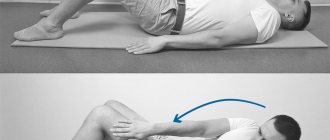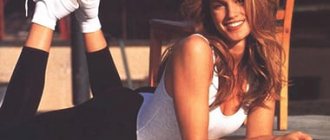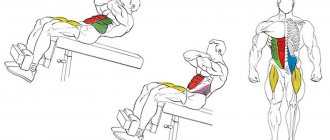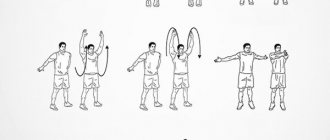Why a kettlebell?
The first question I ask a kettlebell training expert is: why kettlebell?
“Its advantage is that it is a projectile with a shifted center of gravity,” says Maria Larina. — For a dumbbell or barbell, it is located exactly in the center, but for a kettlebell it moves closer to the bottom, because there is a handle on top. This design allows the weight, unlike other projectiles, to seem to fly.” What's the use of a flying weight? Maria explains: training with a kettlebell involves smooth and rotational movements that are impossible with dumbbells. You have to not only work with weight, but also control the force of inertia. This requires more effort and - what is important - the effort of the whole body, rather than a separate muscle group .
“Kettlebell exercises are almost never aimed at isolated muscles,” says Maria. - At first glance, it seems that the arms are mainly working, but most often they are only a conductor of energy, and it is actually the abs, hips or buttocks that are working.
The effect of training with a kettlebell
Before talking with Maria, I had already tried an exercise with a kettlebell once - at a CrossFit . It was the so-called swing: we squatted, swung the kettlebell between our legs, and then stood up and pushed it forward to chest level. I easily completed just two sets of 10 reps, but my hips and buttocks hurt for several days.
“Don’t be afraid to lift weights, you’ll love it! - says Maria. — First of all, I appeal to women. It has always been believed that training with kettlebells is a man's domain, but this is not at all true. Try it - and the results will pleasantly surprise you!”
All workouts are quite short, but very effective. Classes combine strength training and intense fat burning. Studies have shown that in just 20 minutes of exercise you spend 230-250 kilocalories .
The best set of exercises with kettlebells
You should start your kettlebell training with these five movements - they are the most effective.
It is very important to follow the correct technique to avoid injury. Please consider working out with a certified trainer before attempting them at home on your own.
Kettlebell swings
Kettlebell swings are a basic exercise to start with. It forces all the major muscles to work while simultaneously burning a large number of calories in a short period of time. It increases strength and endurance. You can do kettlebell swings with one hand or two at once, or alternate them, killing two birds with one stone.
Take a fairly difficult weight that you can lift to chest level at least 10 times in a row. You may be asking, “How will this help with a full body workout?” You can easily guess that moving your upper body doesn't do much for your arms.
Kettlebell swings are a heavy compound exercise. The base is your feet firmly planted on the ground, slightly bent at the knees, and the core is your hips. It is this rod that allows you to pull the weight back between your legs, and pushing your hips forward returns it to its original position. It should look like a catapult, and it is recommended to launch it with the lower body. Remember: swings are not squats. Since your legs are your support, it is important that your hips are higher than your knees.
And let's not forget the body. If you followed the correct technique, your abs will be burning the next day! It's important to keep your shoulders straight (so the weight doesn't pull you down), and stabilizing your back means stabilizing your entire body.
Set a timer and do as many swings as possible. Try this exercise for 10 minutes. Find your pace and keep it. You can do 10 swings, then rest for 30 seconds and start all over again.
Turkish get up with kettlebell
Can't pull yourself up? Then you probably haven't done this exercise. Women often have poorly developed upper bodies, and this is natural, and men have poor stabilizing muscles, but with the help of Turkish get-ups this can be corrected.
The Turkish get up cannot be done using momentum like a swing. In fact, it's quite uncomfortable. Starting in a prone position on the floor, you grab a nearby kettlebell and lift it. You will then slowly pull yourself upward, moving the kettlebell in the air until you reach a vertical position. And then you have to repeat everything in reverse order.
What is the difficulty here? In coordination of movements between arms and legs. Once you get past this, you can increase the number of repetitions of Turkish get-ups.
This exercise may seem silly when you watch someone else do it, but it will work every muscle in your body. And this is not an exaggeration. If you do it often enough, you will find that other exercises become easier for you. Want to strengthen the top? Then go ahead.
Start with a light weight. Seriously, don't try to lift more than you can! Do 5 reps on one side and 5 on the other to warm up for high-intensity kettlebell training.
Kettlebell Snatch
This may be your favorite or hated exercise. If you do enough repetitions, you will feel so powerful that it will become your favorite.
Of all the kettlebell exercises, this is probably the most demanding in terms of endurance and cardiovascular strength. Cardio and strength? So you can skip the treadmill. A couple of laps of the snatch can be a short and effective workout for you.
This movement requires mobility in the shoulders, the same security in the hips you need for the swing, and the strength to hold the kettlebell overhead because you don't want it to fall directly on your head. With this in mind, don't lift the weight too quickly. Only work with weights that you can perform the required number of repetitions with.
You must not forget the technique and it may take some time to master it. When you lift a kettlebell, it's helpful to imagine someone standing behind you. Your arm should not extend until it is behind your head. Remember that this is a full body workout, not just your arms. This movement uses more of the upper body, but most of the energy comes from the legs and hips. A secure grip on your legs in addition to a stable back will help the kettlebell sit directly above your head.
Set a timer for 3 minutes and do as many repetitions as possible. It may not seem like much, but it will seem like a very long time. Try doing 5-10 reps on one side before switching to the other.
Goblet squats with kettlebells
Squats are the best core exercise for developing full-body muscle development with a barbell and dumbbells, but the kettlebell option is often underrated. There is no good reason for this. Many people suffer from squats, whether it's because they have bad knees or too tight thighs. Some simply cannot squat deep enough, while others struggle to keep their back straight. Moral of the story? Squat technique is important and it's worth spending some time perfecting it.
Dumbbell squats also have some benefits, such as helping you increase hip mobility and take on more weight for barbell squats without sacrificing technique. Having weight in front of you, rather than above your head or behind you, will balance you naturally. This helps your body squat in a natural position rather than moving backward or moving from side to side. At the bottom you will get a good boost to return to the starting position.
Plus, the extra weight will help you stay more stable on the ground. In an effort to squat deeper so that your thighs touch your calves, we often find ourselves lifting our heels off the floor or slouching. If you work under heavy loads, you may lose your balance and get injured. And you don't need this under any circumstances.
Kettlebell squats are one of the most functional exercises you can add to your workout, whether it's stretching, warming up, or endurance work.
Finally, when performing squats, all muscles are involved in the work. Contrary to popular belief, proper squats do much more than that: they work the hamstrings, quads, and abs because when done correctly, your body will be tense, forcing each muscle to do its part.
Warm up with squats, focusing on depth, using the heaviest weight you can lift. Do 5-10 reps for a great dynamic stretch that will warm up your hips and knees for further work.
Army press
Lifting weights overhead is hard work. So lifting weights overhead is a pretty clear indicator that you're going to have an amazing workout. With that said, you can't ignore the military press.
This exercise works the shoulders, back muscles and arms. During this lift, the abs also work. You can do as many squats as you want (and you probably don't want to), but nothing works your abs and makes them strong like lifting weights.
You can simply lift the weight without using your legs. If you want to make the exercise a little more challenging, you can push with your abs, which requires you to bend your knees slightly as you lift the weight. If you want to become very strong, increase the weight. A double weight kettlebell will give you twice the fun.
Keeping your legs stable, your back as straight as possible (don't let the weight tilt you to the side) and your stance as narrow as possible will help you maintain tension. Tension is the determining factor in the success of every lift.
You can use any weight of kettlebell you want for this exercise, but it is helpful to use heavier ones. Set yourself a goal that you want to achieve, and each time take a weight that brings you closer to this goal, over time you will achieve it.
Who invented training with kettlebells?
All these features were noted in the late 90s by a former Soviet soldier, and now a consultant to the US Marine Corps and famous fitness instructor Pavel Tsatsouline . He began to develop kettlebell fitness in the USA: he took exercises from kettlebell lifting as a basis and came up with new ones in addition to them. Over the course of ten years, this movement quickly gained popularity, and now in the States there is already a system of certification of kettlebell fitness trainers, and Tsatsouline, as the founder of the discipline, all weightlifters simply call Pavel and are happy to get a photo with his handshake.
In Russia, the birthplace of kettlebell lifting, kettlebell fitness is just beginning to penetrate. Only a couple of fitness clubs develop it, and exercises with weights are also used in CrossFit training. But thanks to activists like Maria Larina, the situation can change very soon.
Equipment for training with kettlebells
If you have no training experience at all, Maria recommends starting to train with a 5-6 kg weight and increasing the weight to 8 kg as soon as possible. Those who are already confident in lifting weights need to start with 12 kg .
You can do kettlebell fitness in any comfortable sportswear, but there are special requirements for shoes. It's better not to have it at all. If working out barefoot is uncomfortable, then wear sneakers or flat-soled sneakers, as shock-absorbing running shoes will not work. When training with kettlebells, it is important to stand very firmly on the floor and feel the support in your heels. If the heel is raised, the center of gravity will shift forward, the exercise technique will be disrupted, and the load will be removed from the target muscles. For example, if the hamstring muscles are shortened, they will produce less work needed.
Quick leg workout with kettlebells
Circuit training
Kettlebell squats
- 10 sets of 10,9,8,7,6,5,4,3,2,1 reps
- Body part: Quadriceps Equipment: Kettlebells
Swing a kettlebell with one hand
- 10 sets of 10,9,8,7,6,5,4,3,2,1 repetitions with each arm
- Body part: Hamstrings Equipment: Kettlebells
Add to Calendar * Add to My Workouts * Print Workout
* — The service is in beta testing
Full body workout from Victor Blud
The next complex also contains only 3 exercises: snatch, jerk and lunge. They are performed sequentially in a circular format with the number of repetitions increasing from 1 to 10 using a ladder. Thus, you have to complete 10 laps in total. Keep an eye on your technique.
Full body circuit training with kettlebells
Use the pyramid principle: start each kettlebell workout with one repetition of each exercise.
Perform the exercises sequentially only with your right hand, without taking breaks or letting go of the weight. Having completed the approach, return to the first exercise, but perform 2 repetitions with the same arm, and so on - up to 5 repetitions.
Take a break for 2 minutes and repeat the complex for your left hand.
Kettlebell exercises for women: a beautiful body in 20 minutes a day!
1. Kettlebell rotation
Warm-up exercise. Take the weight with both hands, place your feet shoulder-width apart, open your shoulders. Rotate the kettlebell around yourself, grabbing it with your other hand in front of you and behind your back. You can put your feet together and then you will increase the load on the buttocks. Rotate the kettlebell for 30 seconds in each direction.
2. Swing with two hands
Exercise for the muscles of the legs (emphasis on the back of the thigh) and buttocks, as well as for developing endurance. Stand with your feet slightly wider than shoulder-width apart, rest your weight on your heels, and place the kettlebell slightly in front of you. Push your hips back (like a deadlift) until you can comfortably grasp the kettlebell. Don't intentionally bend your knees - they should bend slightly following the movement of your hips. Maintaining the natural arch of your back, grasp the kettlebell with both hands. Swing the kettlebell between your legs, and then straighten your legs and body with a jerking motion. The weight should pass forward and upward between your legs and stop at chest level. Do not make any effort with your arms - the movement should occur through a jerk of your hips. Without slowing down, repeat the swing between your legs. Focus on sharply straightening your hips, tightening your abs and buttocks. Perform 15 repetitions.
3. Belt pull
Exercise for the back muscles. Grasp the kettlebell with one hand and step forward into a shallow lunge with your opposite leg. Place your free hand on your leg. Pull the kettlebell towards you, moving your elbow back. Keep your shoulders turned, your abs tense, and maintain the natural arch of your back. Perform 10 repetitions.
4. Repeat the swing
5. Repeat the row with your right hand.
6. Repeat the swing.
7. Standing press (“military press”)
Exercise for triceps and deltoid muscles. Bend your arm and lift the weight toward your shoulder. Hold the kettlebell without bending your wrist. Lower your free hand down, transfer your body weight to your heels. Press the weight upward until your arm is fully extended. In the upper position, turn your hand away from you, pointing your palm forward. Maintain tension in the muscles of the abs, buttocks and back. Pull your arm straight up, without leaning forward, so that there is no tilt in the shoulder joint. Perform one approach with only your left hand: with a weight of 4-5 kg - 10 repetitions, with a weight of 8 kg - 5 repetitions.
8. Repeat the swing.
9. Repeat the standing press with your right arm.
10. Repeat the swing.
11. Hot potatoes
Exercise for the abdominal muscles. Place your feet slightly wider than your shoulders and hold the weight in your hands upside down. Bend your arms and slowly transfer the weight from one hand to the other, holding it at approximately shoulder level. At the initial stage, the distance between the hands should be no more than 5 cm. Over time, you can increase both the distance and the speed of shifting. Be sure to keep your abdominal muscles tense. Perform for 1 minute.
12. Repeat the swing.
13. Repeat rotating the weights for 30 seconds in both directions.
14. Perform the final swing.
After completing the exercises, walk a little at a calm pace, then do stretching exercises for the muscles of the whole body.
Strength training program
You should “start” with a light weight - a sports equipment of 16 kilograms, then, when the complex has already been mastered, move on to heavier ones - 24 or 32 kilograms. Girls should first take an 8-kilogram “children’s” weight. This will allow the body: joints, ligaments, muscles to get used to the new type of load, and also minimize the risk of injury.
An approximate set of exercises with weights:
- Overhead press. Stand straight, feet shoulder-width apart, the weight is centered between your feet. Bend over with a straight back, take the weight (it is better to wrap the handle with non-slip material or wear gloves), straighten up, raise your arm so that the weight is behind your shoulder (it should be on the outside of the arm), squeeze your arm up to its full length, so that the projectile was almost over my head. Hold for 1-2 seconds, then lower the weight first over your shoulder, then to the floor. Repeat without pause 5-10 times.
- Lifting with two hands. Take the starting position: feet shoulder-width apart, weights on the floor, hands on the handle of the weights. Straighten up, holding the apparatus as close to your body as possible, hold the weight at chest level and raise your arms above your head. After a second pause, lower your arms to your chest - hold - take the starting position. Perform 8-12 repetitions.
- Belt pull. Starting position: feet at a palm's distance. Take the weight with your hand, make a small lunge with your leg forward, and rest your free hand on the knee of your forward leg. Raise the projectile to waist level, while moving your elbow back, but do not push it to the side. Keep your abs toned and your shoulders turned. Perform a delay at the extreme point and place the weight on the floor. Set – 10 repetitions.
- Squat. Take the starting position: feet two palms apart, back straight, weights in both hands at chest level. Slowly, with a straight back, begin to squat. When your thighs are parallel to the floor, hold for 1-2 seconds and begin lifting, “pushing” your body up with the muscles of your legs and buttocks. Perform 10-15 repetitions.
- Swing or swing. Get into the starting position: feet slightly wider than shoulder-width apart, place the weight straight in front of you. Bend over, moving your hips back (as if sitting down), take the weight with both hands, and place it between your legs. Straighten up, bringing your hips forward, sharply “throwing” your arms to chest level. The main thing is to lift the weight not with your hands, but through the efforts of your hips and buttocks. Then return the weight and take the starting position. Do 10-15 repetitions without a break.
The training program includes alternating various exercises for 1-2 sets. For example: overhead swing press - squats - rows. But, as already mentioned, it is better to start classes under the supervision of a trainer: he will help you calculate the required load, the pace of repetitions, and the number of approaches. Our Gold`s Gym fitness centers employ only professionals who have been involved in strength sports for several years. They will be able not only to give advice, but also to actively support the novice athlete. And to alternate strength training with aerobic exercise, you can choose one of the types of cardio classes: swimming, fitness dancing, yoga. Take care of your body, make it healthy and beautiful!










